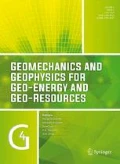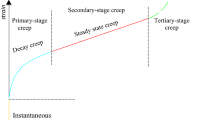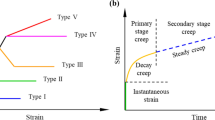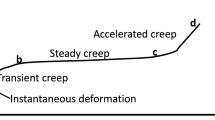Abstract
A rheological constitutive model for damaged zone evolution of a tunnel is proposed in this paper to describe the strain hardening and softening properties of the excavation-disturbed rock mass. Firstly, the one-dimension rheological model is introduced by connecting the improved St. Venant body with the Nishihara model, and this model can be used to describe the whole process including transient viscoplastic creep under a low-stress state, steady-state and accelerative creep under a high-stress state. Secondly, the constitutive equations of the rheological model under three-dimensional condition of the improved St. Venant body based on generalized plasticity potential theory are deduced, and the generic three-dimensional rheological model is developed. Thirdly, the creep and stress relaxation properties of the rheological model are studied and discussed. Furthermore, numerical analysis of triaxial compression tests and triaxial compression creep tests are conducted and the rheological model are validated. The results show that the rheological model can be used to study the evolution of excavation damaged zone in underground tunnel engineering.












Similar content being viewed by others
References
Alejano LR, Alonso E (2005) Considerations of the dilatancy angle in rocks and rock masses. Int J Rock Mech Min Sci 42(4):481–507
Barton N, Choubey V (1977) The shear strength of rock joints in theory and practice. Rock Mech 10(1–2):1–54
Chen Z, Wang ML, Lu T (1997) Study of tertiary creep of rock salt. J Eng Mech 123(1):77–82
Drucker DC, Prager W (1952) Soil mechanics and plastic analysis or limit design. Q Appl Math 10(2):157–165
He GH, Wang EZ, Liu XL (2016) Modified governing equation and numerical simulation of seepage flow in a single fracture with three-dimensional roughness. Arab J Geosci 9:81
Hoek E, Brown ET (1997) Practical estimates of rock mass strength. Int J Rock Mech Min Sci 34(8):1165–1186
Hunsche U, Hampel A (1999) Rock salt—the mechanical properties of the host rock material for a radioactive waste repository. Eng Geol 52(3):271–291
Kang JQ, Zhu JB, Zhao J (2019) A review of mechanisms of induced earthquakes: from a view of rock mechanics. Geomech Geophys Geo-Energy Geo-Resour 5:171–196
Li S, Liu XL, Li R, Su YW (2017) Shear deformation dominates in the soft adhesive layers of the laminated structure of flexible electronics. Int J Solids Struct 110:305–314
Liu XL, Wang SJ, Wang EZ, Xue Q (2006a) Study on time-dependent swelling constitute relation of swelling rock. J Hydraul Eng 37(2):195–199 (In Chinese)
Liu XL, Wang SJ, Wang EZ, Xue Q (2006b) Double-medium constitutive model of geological material in uniaxial tension and compression. Appl Math Mech 27:1361–1372
Liu XL, Wang SJ, Wang SY, Wang EZ (2015) Fluid-driven fractures in granular materials. Bull Eng Geol Environ 74(2):621–636
Liu XL, Han GF, Wang EX, Wang SJ, Kumar N (2018) Multiscale hierarchical analysis of rock mass and prediction of its mechanical and hydraulic properties. J Rock Mech Geotech Eng 10:694–702
Liu XL, Wang F, Huang J, Wang SJ, Zhang ZZ, Kumar N (2019) Grout diffusion in silty fine sand stratum with high groundwater level for tunnel construction. Tunn Undergr Space Technol 93:103051
Maranini E, Yamaguchi T (2001) A non-associated viscoplastic model for the behaviour of granite in triaxial compression. Mech Mater 33(5):283–293
Nicolae M (1999) Non-associated elasto–viscoplastic models for rock salt. Int J Eng Sci 37(3):269–297
Sun J (2007) Rock rheological mechanics and its advance in engineering applications. Chin J Rock Mechan Eng 26(6):1081–1106
Sun H, Liu XL, Zhu JB (2019) Correlational fractal characterisation of stress and acoustic emission during coal and rock failure under multilevel dynamic loading. Int J Rock Mech Min Sci 117:1–10
Tang H, Wang D, Huang R, Pei X, Chen W (2018) A new rock creep model based on variable-order fractional derivatives and continuum damage mechanics. Bull Eng Geol Environ 77(1):375–383
Wu F, Chen J, Zou Q (2019) A nonlinear creep damage model for salt rock. Int J Damage Mech 28(5):758–771
Xia CC, Wang XD, Xu CB, Zhang CS (2008) Method to identify rheological models by unified rheological model theory and case study. Chin J Rock Mech Eng 27(8):1594–1600
Xie HP, Zhu JB, Zhou T, Zhang K, Zhou CT (2020) Conceptualization and preliminary study of engineering disturbed rock dynamics. Geomech Geophys Geo-Energy Geo-Resour 6:34. https://doi.org/10.1007/s40948-020-00157-x
Yang SQ, Xu P, Xu T (2015) Nonlinear visco-elastic and accelerating creep model for coal under conventional triaxial compression. Geomech Geophys Geo-Energy Geo-Resour 1(3–4):109–120
Yin GZ, Wang H, Zhang DM (2011) Creep experimental and theory model on coal containing gas under the condition of unloading confining pressure. J China Coal Soc 36(12):1963–1967 (in Chinese)
Yu MH, Yang SY, Fan SC (1999) Unified elasto-plastic associated and non-associated constitutive model and its engineering applications. Comput Struct 71(6):627–636
Yuan SC, Harrison JP (2004) An empirical dilatancy index for the dilatant deformation of rock. Int J Rock Mech Min Sci 41(4):679–686
Zhao XG, Cai M (2010) A mobilized dilation angle model for rocks. Int J Rock Mech Min Sci 47(3):368–384
Zhao Y, Zhang L, Wang W, Wan W, Ma W (2018) Separation of elastoviscoplastic strains of rock and a nonlinear creep model. Int J Geomech 18(1):1–18
Zhou HW, Wang CP, Han BB, Duan ZQ (2011) A creep constitutive model for salt rock based on fractional derivatives. Int J Rock Mech Min Sci 48(1):116–121
Zienkiewicz OC, Panda GN (1977) Some useful forms of isotropic yield surfaces for soil and rock mechanics. In: Gudehus G (ed) Finite element in geomechanics. Wiley, London, pp 179–190
Acknowledgements
This work was financially supported by the National Natural Science Foundation of China (No. 51934003, 51774020 and U1204509), Program for Yunnan Thousand Talents Plan High-level Innovation and Entrepreneurship Team, and Program for Innovative Research Team (in Science and Technology) in University of Yunnan Province.
Author information
Authors and Affiliations
Corresponding author
Ethics declarations
Conflict of interest
The authors whose names listed in this article certify that there is no actual or potential conflict of interest in relation to this work.
Additional information
Publisher's Note
Springer Nature remains neutral with regard to jurisdictional claims in published maps and institutional affiliations.
Rights and permissions
About this article
Cite this article
Zhang, Z., Liu, X., Cheng, L. et al. A rheological constitutive model for damaged zone evolution of a tunnel considering strain hardening and softening. Geomech. Geophys. Geo-energ. Geo-resour. 6, 56 (2020). https://doi.org/10.1007/s40948-020-00181-x
Received:
Accepted:
Published:
DOI: https://doi.org/10.1007/s40948-020-00181-x




